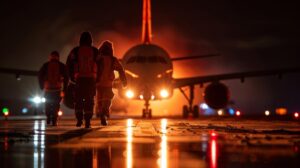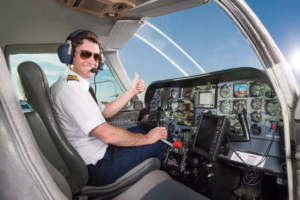Aviation is a complex field, requiring precision, skill, and extensive knowledge. Getting a type rating is one of the most important parts of becoming a certified pilot. But what exactly is a type rating, and why is it crucial for pilots?
This article delves into the importance of type ratings in aviation, explaining what they are, why they matter, and how pilots can obtain them. So let’s take a look without any further delay.
Understanding What is Type Rating: A Specialized Certification
A type rating is a license endorsement that a holder of a generic pilot’s license, for instance, a Private Pilot License (PL) or Commercial Pilot License (CPL), must undertake. This certification enables a pilot to fly a particular model of an aircraft, often big and complicated aircraft such as commercial and personal aircraft of certain models.
In simple terms whilst a pilot’s license permits a pilot to fly aircraft displaying at any given time one or another category and class (for example engine land aircraft) a type rating is needed for certain sorts of models. For instance, if a pilot is approved to maneuver a single-engine aircraft, he cannot conduct a Boeing 737 without further permission. For example, when converting from flying an L-boat or some easy-to-fly fixed-wing aircraft to flying airliners or passenger transport, different training and certifications are needed, and this is why there is a type rating.
Why is Type Rating Crucial?
The foremost importance of type ratings has to do with safety. Same type of aircraft may have differences in the type of design, the way it is expected to perform, and its operational procedures. For instance, the cockpit design the controls, and the emergency features are not the same in Boeing 747 and Airbus A320. It will be necessary for a pilot to know specific details of a particular aircraft’s systems, operational characteristics or capabilities, and emergencies.
Complexity of Modern Aircraft:
Contemporary aircraft are complex devices that incorporate avionics, automation, and certain flight processes. Such machines are operated by special systems which differ from those general aviation training teaches you. This is the information type ratings give, thus making the pilots well-equipped to handle the specific aircraft.
Regulatory Requirements:
Many authorities across the globe, including the FAA for the United States and EASA for Europe, require operators of specific aircraft to have type ratings. These regulations are very vital in preventing the operation of complex aircraft by unqualified pilots to reduce the danger to the passengers, crew, and the public.
Emergency Preparedness:

As for an emergency situation, the prompt and correct reaction is the key factor that has to be oriented by a pilot. For each of the aircraft in service, there are specific procedures in case of emergency, and this is something a pilot has to learn. A type rating gives the pilot the knowledge on how to accomplish different sequences inherent to the type of aircraft, thus lowering the possibility of mishaps.
Also Read: Importance Of Safety In Aviation Training
Insurance and Liability:
Insurance can also demand that pilots have a type rating for certain aircraft’ before they are extended an insurance policy. This requirement is because these aircraft are of high value and there are a lot of risks that might emanate from the operations of the aircraft. A type rating ensures that the insurer that the pilot is qualified to fly the plane and is in a position to avoid any costly accidents.
How to Obtain a Type Rating
The process of obtaining a type rating involves both ground school and flight training. The specifics of the training can vary depending on the aircraft type and the regulatory body overseeing the certification, but the general process includes the following steps:
Ground School:

Ground school is one of the steps to be taken as a candidate goes through the process of type rating. This comprises classroom study as well as ground training using simulators in which the pilot is given a working knowledge of the special characteristics and operational conditions of the particular aircraft. The following are other subjects taught in ground school; avionics, engine systems and hydraulic systems, electrical systems, flight planning, and emergency procedures. They also get acquainted with the aircraft systems such as the flight management systems FMS and other mandatory systems used in today’s aircraft.
Simulator Training:

After passing through the ground school, the pilots take many hours flying what is referred to as flight simulators that mimic the actual aircraft type. These simulators are very complex and offer near actual conditions to the pilots and they employ a range of flight operations such as taking-off, landing, and instances of emergency. Through the use of simulator training, pilots can be trained with the feeling and functionality of the aircraft without being airborne.
Flight Training:
Following the completion of flight simulators, pilots proceed to their flight training and they manipulate the plane through the assistance of a flight instructor. It includes conducting normal and abnormal drills, operating the aircraft in various kinds of weather, and abroad various phases of a flight such as take-off, intermediate, and landing. It confirms the pilot’s competence to fly the aircraft in conditions that exist in practice.
Check Ride:
The check ride, also known as the type rating examination, is the final step in obtaining a type rating. On a check ride, a pilot is required to control the airplane and show how to maneuver the aircraft in a safe and efficient manner. It is taken by a check rider, who evaluates the knowledge of the pilot about the aircraft system, normal and emergency maneuvers, and proficiency in flight. If the pilot manages to pass the check ride then the candidate is issued with the type rating for such aircraft.
The Role of Type Ratings in Career Advancement
From the perspective of the individual pilot, professional pilots possessing multiple type ratings can be a definite advantage. Since there is a drive for pilots to be able to operate in at least two categories of aircraft, this play avoids complications such as constantly training pilots to fly various aircraft, and hiring at different charter companies as most of the airline companies prefer that. Moreover, the holder of more than one type of rating stands a better chance of getting a wider market to work in, and his remuneration will be higher.
For example, a pilot who has type ratings of Boeing 737 and Airbus A320 will have more employment than a pilot with only one type rating of Boeing 737. Also, some pilots train for type ratings for high-performance jets or corporation aircraft to work in the high-priced business aviation.
Conclusion
In conclusion, it is possible to state that the type rating is one of the vitally important certifications for pilots which allows them to ensure the optimal level of their preparedness for consummate flight of definite aircraft. This is the reason why most of the modern airplane types will call for type ratings with the continual development of technology in aviation and the complexities of systems and procedures. To any would-be pilot, it becomes very crucial to appreciate the importance of type ratings and then go out to pursue them as a way of ensuring that an individual has a very successful flying career without having to compromise on safety.
FAQ
Is recurrent training required after obtaining a type rating?
Yes, recurrent training is mandatory to maintain a type rating. Pilots must undergo this training regularly, typically every six to twelve months, to refresh their knowledge and ensure they remain proficient in operating the aircraft. This ongoing training is crucial for maintaining safety and staying current with any updates or changes to the aircraft’s systems.
Can a pilot have multiple types of ratings?
Yes, a pilot can hold multiple type ratings for different aircraft types. Having multiple type ratings can be advantageous in a pilot’s career, as it increases their versatility and employability. For example, a pilot with type ratings for both the Boeing 737 and Airbus A320 may have more job opportunities compared to a pilot with only one type rating.
Are type ratings only required for large commercial aircraft?
While type ratings are commonly associated with large commercial aircraft, they can also be required for smaller aircraft, especially those that are complex or have unique handling characteristics. Some high-performance jets, corporate aircraft, and certain turboprops also require pilots to have a type rating to operate them legally and safely.
